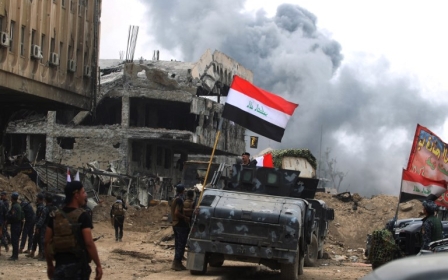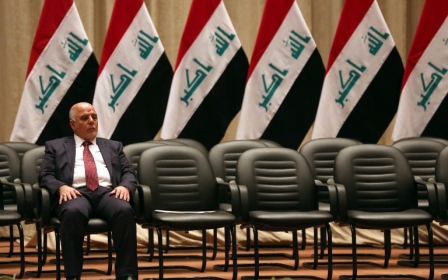The final defeat of IS in Mosul? Not by a long shot

After fierce fighting which started on 17 October in Mosul and lasted more than eight months, turning most of the city’s neighbourhoods into rubble, Iraqi Prime Minister Haider al-Abadi announced a victory over the Islamic State (IS) group on 10 July.
After the collapse of the Iraqi army and police forces and their escape and withdrawal on 10 June 2014, IS was able to take Mosul within eight hours and with very few combatants and equipment.
The capture of the city led to two key developments. On 13 June 2014, Iraq's highest-ranking Shia cleric, Grand Ayatollah Ali al-Sistani, issued a holy fatwa - “jihad al-kafai” - which called for the formation a Shia militia to support the army and police forces. Then, in September 2014, an international, US-led alliance aiming to expel IS from Mosul and other cities it controlled in Iraq and Syria was formed.
IS's bombing of the al-Nuri Mosque and the al-Hadba Minaret, he said, were "in fact an announcement of the end of the little and void state of IS".
However, reality proves Abadi’s statements are not credible. The defeat and expulsion of IS from Mosul does not spell its end, and it seems much too early for Abadi to talk about the end of IS given the political tug of war inside the country.
Raids, explosions and suicide bombs
Talking about the end of IS in Iraq is nothing but wishful thinking that indicates an ignorance of IS’s nature.
If IS loses more territory, it will simply reinstate itself as an armed organisation engaging in unconventional warfare
It is possible to talk of a temporary end of IS’s political project as a “state” which has structures of power and governance that have dominated major urban areas, like Mosul and Raqqa, imposing its governmental system with a military formation based on classic warfare tactics.
However, IS will return to its original form and maintain its presence as an “organisation” with an ideology, an organisational structure and funding that is mainly based on the tactics of guerrilla warfare and attrition.
In addition to IS’s ability to adapt over the course of the war, it still controls large areas. The Iraqi forces and the International Alliance are preparing for many battles after Mosul to expel IS from the territories it controls in Iraq, as well as for the complexities of the battles in Syria and the battle that is going on in the city of Raqqa.
IS still controls a number of areas in Iraq, notably Hawija in Kirkuk governorate in the north of the country, and parts of al-Shirqat in Saladin governorate, Tal Afar in western Mosul in the province of Nineveh and al-Qa'im in al-Anbar governorate in the west of the country.
With the end of IS’s state project, the group will revert to its reality as a terrorist organisation with the strategies of attrition and guerrilla tactics which it had developed before seizing cities in Iraq and Syria and declaring its state.
These strategies rely on quick raids by gunmen, improvised explosive charges, car bombs and suicide bombers hiding in undercover cells mixed in with civilians. IS’s military council has developed a pattern of hybrid war which can quickly adapt to shifts in the field, moving from classical battle to this type of guerrilla warfare based on agile forces capable of exhausting attacking forces.
The real battle
With its tactical prowess, it could be said that IS is self-sufficient as a jihadist organisation. But the real strength of IS comes mostly from the political conditions of the post-occupation Iraq – from the “Sunni crisis”.
Iraq’s sharp contradictions contribute to its instability and could reproduce the same conditions which led to the rise of IS
With the emergence of the “sectarian issue” and the dominance of a dictatorial government with its Shia components, Sunnis were excluded from the country’s political process.
So the future of IS in Iraq depends on the success of the political process in an ethnically and racially divided country.
The real challenge only begins with the end of military operations and the lack of clear political vision for how to manage Mosul and other Sunni cities, in addition to the absence of practical plans, resources and financial allocations that would put the issue of reconstruction and the return of the displaced on the table.
It is unlikely that the Iraqi government will be able to fulfil its promises to the devastated Sunni governorates, and the crisis of confidence between the Sunni and Shia components will be aggravated.
The end of IS in Iraq is a long way off. In reality, Iraq’s sharp contradictions contribute to its instability and could reproduce the same conditions which led to the rise of IS and its control over large areas.
The intensification of the Shia-Kurdish conflict, for example, could lead to a civil war, especially with the insistence of Massoud Barzani, president of the Kurdistan Regional Government, to hold a referendum on Kurdish independence on 25 September.
Indeed, the referendum will not be limited to the borders of Kurdistan, but will include the areas of conflicts where there are Kurds and which are currently under the control of the Kurdish militias.
The growing strength of Shia militias that are affiliated with Iran and represented in the Popular Mobilisation will incite sectarian strife and, because of their insistence on controlling Sunni areas on the Iraqi-Syrian border, might also cause conflicts with US forces in Iraq.
In late May, these Shia militias, which are supported by Iran, rushed to control large areas which do not include any Shia citizens. This is part of an Iranian plan which aims to link the battlefields in Iraq and Syria and to integrate the political destiny of both countries in preparation for the establishment of a connected ground passage between Iran and Lebanon.
These complicated problems in Iraq work in favour of the continuation and the sustainability of IS. IS in Iraq is ultimately the outcome of the “Sunni crisis”. Without a political process that seeks to integrate the Sunnis and realise their fair demands, IS will return in many forms and it might even be more brutal.
- Hassan Abu Haniyeh is a Jordanian researcher.
The views expressed in this article belong to the author and do not necessarily reflect the editorial policy of Middle East Eye.
Image: Members of the Iraqi federal police march with national flags during a celebration in the Old City of Mosul on 2 JUly 2017 (AFP)
This article is available in French on Middle East Eye French edition.
Stay informed with MEE's newsletters
Sign up to get the latest alerts, insights and analysis, starting with Turkey Unpacked
Middle East Eye delivers independent and unrivalled coverage and analysis of the Middle East, North Africa and beyond. To learn more about republishing this content and the associated fees, please fill out this form. More about MEE can be found here.







